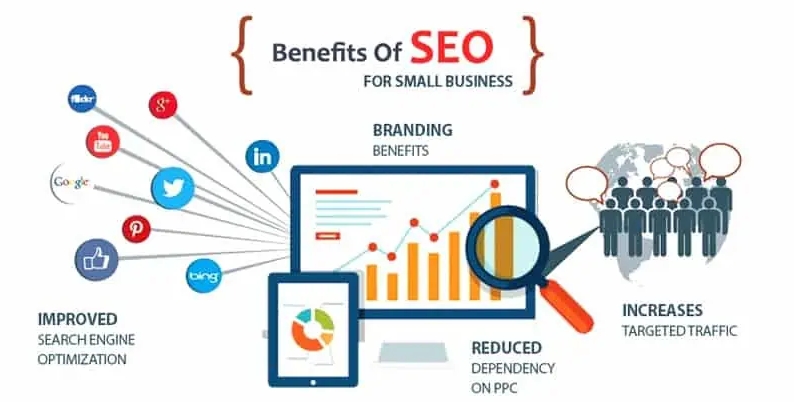What Is SEO – Search Engine Optimization? How Does it Work?
In today's digital age, where online visibility can make or break a business, understanding the fundamentals of Search Engine Optimization (SEO) is essential. SEO is the practice of optimizing your website to improve its visibility in search engine results pages (SERPs) and attract organic traffic. This article aims to demystify SEO by providing a comprehensive overview of its concepts, strategies, and best practices.
What Is SEO?
Search Engine Optimization, more commonly known by its acronym SEO, refers to the practice of enhancing a website or online content to improve its visibility on search engines. The primary objective of SEO is to increase organic, or non-paid, traffic to a site through higher search engine rankings.

Why Is SEO Essential?
Increased Visibility:
SEO helps improve a website's visibility in search engine results pages (SERPs). By optimizing for relevant keywords and improving website structure, content, and performance, SEO increases the likelihood of appearing at the top of search results, making it easier for users to find your website.
Higher Organic Traffic:
Appearing at the top of search results can significantly increase organic traffic to your website. Users tend to click on the top-ranking results, so higher visibility leads to more clicks, visits, and potential conversions.
Cost-Effective Marketing:
Unlike paid advertising, which requires ongoing investment, SEO is a cost-effective marketing strategy in the long term. Once your website ranks well for target keywords, you can attract organic traffic without continuously paying for clicks or impressions.
Builds Credibility and Trust:
Websites that rank higher in search results are often perceived as more credible and trustworthy by users. By optimizing for SEO, you demonstrate to search engines and users alike that your website offers valuable, relevant content and a positive user experience.
Better User Experience:
SEO involves optimizing website elements such as page speed, mobile-friendliness, and navigation, which enhances the overall user experience. A well-optimized website is easier to navigate, loads faster, and provides valuable information, leading to higher user satisfaction and engagement.

How Does SEO Work?
SEO works by aligning a website's content, structure, and other elements with the criteria used by search engines to determine rankings. While the exact algorithms used by search engines like Google are proprietary and constantly evolving, SEO practitioners focus on optimizing the following key elements:
On-Page SEO:
On-page SEO involves optimizing individual web pages to improve their relevance and authority in the eyes of search engines. This includes optimizing meta tags (title, description, headings), incorporating relevant keywords, optimizing content structure and readability, and improving page load speed and mobile-friendliness.

Off-Page SEO:
Off-page SEO refers to strategies implemented outside of the website to improve its authority and credibility. This includes building backlinks from reputable websites, leveraging social media to amplify content, and participating in online communities and forums to increase brand visibility and reputation.

Technical SEO:
Technical SEO focuses on optimizing the technical aspects of a website to ensure it is crawlable, indexable, and accessible to search engines. This includes optimizing website structure and navigation, implementing schema markup for enhanced visibility in search results, improving site speed and performance, and ensuring proper URL structure and canonicalization.

Content Optimization:
Content optimization involves creating high-quality, relevant, and engaging content that satisfies user intent and provides value to the target audience. This includes conducting keyword research to identify topics and phrases that resonate with users, optimizing content for target keywords, incorporating multimedia elements (images, videos), and regularly updating and refreshing content to keep it relevant and engaging.

User Experience (UX) Optimization:
User experience optimization focuses on providing visitors with a seamless and intuitive browsing experience that encourages engagement and conversion. This includes optimizing website navigation and internal linking structure, improving page layout and design, optimizing forms and CTAs for usability, and ensuring fast load times and mobile responsiveness.

Role of keywords
Keywords are the foundation of SEO and play a crucial role in determining a website's visibility in search results. Keyword research involves identifying the terms and phrases that users are searching for in relation to your business or industry. By strategically incorporating these keywords into your website content, meta tags, and other elements, you can improve your chances of ranking higher in search results for relevant queries.
Types of Keywords:
Short-Tail Keywords:
These are broad, generic keywords consisting of one or two words (e.g., "shoes," "digital marketing").

Long-Tail Keywords:
These are more specific and targeted keywords consisting of three or more words (e.g., "best running shoes for women," "digital marketing tips for startups").

Branded Keywords:
These are keywords that include your brand name or variations thereof (e.g., "Nike shoes," "Nike running shoes").

LSI Keywords (Latent Semantic Indexing):
These are keywords that are semantically related to your target keyword and help search engines understand the context of your content (e.g., "jogging shoes," "athletic footwear").

Implementing SEO Strategies:
Implementing effective SEO strategies requires a combination of technical expertise, content creation skills, and continuous optimization efforts. Here are some key steps to follow:
Conduct Comprehensive Keyword Research:
Start by identifying relevant keywords and phrases that are relevant to your business, products, or services. Use keyword research tools like Google Keyword Planner, SEMrush, or Ahrefs to identify high-volume, low-competition keywords that align with your goals and target audience.

Optimize On-Page Elements:
Optimize on-page elements such as title tags, meta descriptions, headings, and URLs to include target keywords and provide clear, concise information about your content. Use descriptive and compelling language to entice users to click on your search listings.

Create High-Quality Content:
Create informative, engaging, and well-structured content that addresses the needs and interests of your target audience. Focus on providing value and solving problems for your users rather than solely optimizing for search engines. Incorporate target keywords naturally throughout your content, but avoid keyword stuffing or over-optimization.

Build Quality Backlinks:
Build high-quality backlinks from authoritative and relevant websites to improve your website's authority and credibility in the eyes of search engines. Focus on acquiring natural and organic backlinks through guest blogging, influencer outreach, and content promotion strategies. Avoid low-quality or spammy backlinks, as they can harm your website's rankings.

Optimize for Mobile and Voice Search:
With the increasing prevalence of mobile and voice search, it's essential to optimize your website for these platforms. Ensure your website is mobile-responsive and loads quickly on mobile devices. Optimize your content for voice search queries by targeting conversational and long-tail keywords and providing concise, direct answers to common questions.

Monitor and Analyze Performance:
Regularly monitor your website's performance using web analytics tools like Google Analytics and Google Search Console. Track key metrics such as organic traffic, keyword rankings, click-through rates, and conversion rates to assess the effectiveness of your SEO efforts. Use this data to identify areas for improvement and adjust your strategy accordingly.

Conclusion:
Search Engine Optimization (SEO) is a dynamic and multifaceted discipline that plays a critical role in driving organic traffic, improving online visibility, and ultimately, achieving business success. By understanding the core principles of SEO and implementing effective strategies, businesses can enhance their search engine rankings, attract more qualified leads, and establish a strong online presence in today's competitive digital landscape.







.png)






